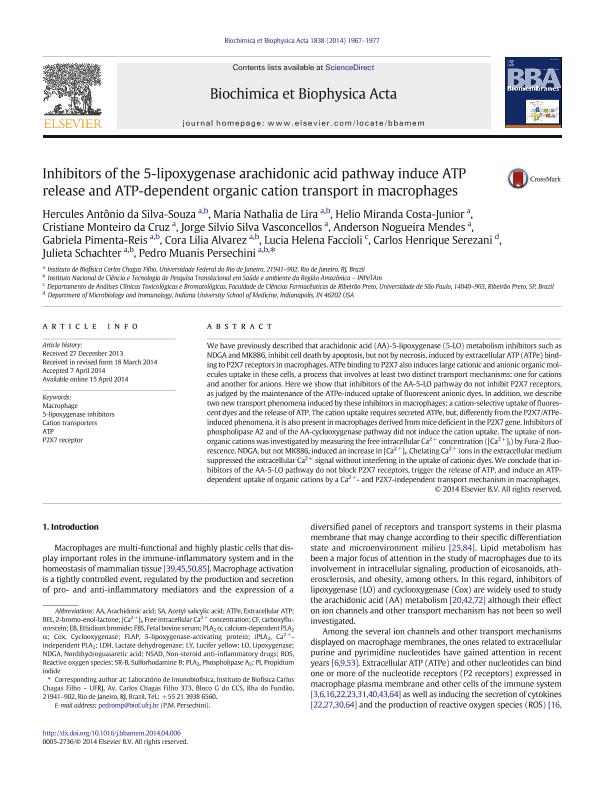Artículo
Inhibitors of the 5-lipoxygenase arachidonic acid pathway induce ATP release and ATP-dependent organic cation transport in macrophages
Silva Souza, Hercules Antônio da; Lira, Maria Nathalia de; Costa Junior, Helio Miranda; Cruz, Cristiane Monteiro da; Silva Vasconcellos, Jorge Silvio; Nogueira Mendes, Anderson; Pimenta Reis, Gabriela; Alvarez, Cora Lilia ; Faccioli, Lucia Helena; Serezani, Carlos Henrique; Schachter, Julieta; Muanis Persechini, Pedro
; Faccioli, Lucia Helena; Serezani, Carlos Henrique; Schachter, Julieta; Muanis Persechini, Pedro
 ; Faccioli, Lucia Helena; Serezani, Carlos Henrique; Schachter, Julieta; Muanis Persechini, Pedro
; Faccioli, Lucia Helena; Serezani, Carlos Henrique; Schachter, Julieta; Muanis Persechini, Pedro
Fecha de publicación:
04/2014
Editorial:
Elsevier Science
Revista:
Biochimica et Biophysica Acta - Biomembranes
ISSN:
0005-2736
Idioma:
Inglés
Tipo de recurso:
Artículo publicado
Clasificación temática:
Resumen
We have previously described that arachidonic acid (AA)-5-lipoxygenase (5-LO) metabolism inhibitors such as NDGA and MK886, inhibit cell death by apoptosis, but not by necrosis, induced by extracellular ATP (ATPe) binding to P2X7 receptors in macrophages. ATPe binding to P2X7 also induces large cationic and anionic organic molecules uptake in these cells, a process that involves at least two distinct transport mechanisms: one for cations and another for anions. Here we show that inhibitors of the AA-5-LO pathway do not inhibit P2X7 receptors, as judged by the maintenance of the ATPe-induced uptake of fluorescent anionic dyes. In addition, we describe two new transport phenomena induced by these inhibitors in macrophages: a cation-selective uptake of fluorescent dyes and the release of ATP. The cation uptake requires secreted ATPe, but, differently from the P2X7/ATPe-induced phenomena, it is also present in macrophages derived from mice deficient in the P2X7 gene. Inhibitors of phospholipase A2 and of the AA-cyclooxygenase pathway did not induce the cation uptake. The uptake of non-organic cations was investigated by measuring the free intracellular Ca(2+) concentration ([Ca(2+)]i) by Fura-2 fluorescence. NDGA, but not MK886, induced an increase in [Ca(2+)]i. Chelating Ca(2+) ions in the extracellular medium suppressed the intracellular Ca(2+) signal without interfering in the uptake of cationic dyes. We conclude that inhibitors of the AA-5-LO pathway do not block P2X7 receptors, trigger the release of ATP, and induce an ATP-dependent uptake of organic cations by a Ca(2+)- and P2X7-independent transport mechanism in macrophages.
Palabras clave:
5-Lipoxygenase Inhibitors
,
Atp
,
Cation Transporters
,
Macrophage
,
P2x7 Receptor
Archivos asociados
Licencia
Identificadores
Colecciones
Articulos(IQUIFIB)
Articulos de INST.DE QUIMICA Y FISICO-QUIMICA BIOLOGICAS "PROF. ALEJANDRO C. PALADINI"
Articulos de INST.DE QUIMICA Y FISICO-QUIMICA BIOLOGICAS "PROF. ALEJANDRO C. PALADINI"
Citación
Silva Souza, Hercules Antônio da; Lira, Maria Nathalia de; Costa Junior, Helio Miranda; Cruz, Cristiane Monteiro da; Silva Vasconcellos, Jorge Silvio; et al.; Inhibitors of the 5-lipoxygenase arachidonic acid pathway induce ATP release and ATP-dependent organic cation transport in macrophages; Elsevier Science; Biochimica et Biophysica Acta - Biomembranes; 1838; 7; 4-2014; 1967-1977
Compartir



